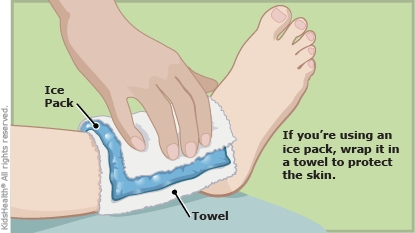Ankle Pain: How to Care for Your Child
Ankle pain can happen for different reasons, and can come on slowly or suddenly. It's often worse during walking. Most cases of ankle pain are not serious and go away with rest and basic home care.


-
Your child should take a break from activities that cause pain or put stress on the ankle, such as running, dancing, martial arts, and jumping. Your child may try a low-impact exercise (such as swimming) as long as it doesn't cause pain.
-
If your child is uncomfortable, you can give acetaminophen (such as Tylenol® or a store brand) OR ibuprofen (such as Advil®, Motrin®, or a store brand), if recommended by your health care provider.
-
Put a cold pack on the ankle for 15–20 minutes every 3–4 hours. Place a towel or cloth between the cold pack and the skin.
-
Make sure your child's shoes fit well and support the foot and ankle. Your child may want to wear a supportive ankle bandage (available at drugstores) for a few days until the ankle feels better.
-
Keep the foot raised when possible to minimize swelling.
-
Your health care provider may recommend specific stretches or exercises, or refer your child to a physical therapist.

Your child:
-
still has pain after following the care instructions
-
has pain that gets worse
-
has pain that wakes him or her at night more than once in a while
-
has a hard time walking
-
develops other symptoms (like fever or a rash)
-
has redness or warmth of the ankle
-
has new or worsening swelling in the ankle

Your child:

What can cause ankle pain? Pain may happen from a strain, a tear, or swelling in the:
-
ligaments (bands that connect bones to other bones)
-
tendons (bands that connect muscle to bone)
-
muscles
-
connective tissues (which support the body's organs, bones, and muscles)
Stress on the bones and inflammation in the joints also can cause pain. Less common causes include infections or growths on the bones.